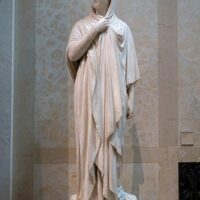Alcestis : The Devoted Queen
Listen
At a glance
| Description | |
|---|---|
| Origin | Greek Mythology |
| Classification | Mortals |
| Family Members | Pelias (Father), Anaxibia (Mother), Acastus, Pisidice, Pelopia, Hippothoe (Siblings), Admetus (Husband) |
| Region | Greece |
| Associated With | Devotion, Sacrifice, Royalty |
Alcestis
Introduction
Alcestis, a luminous figure in Greek mythology, stands as a timeless emblem of selfless devotion and courage. Best known from Euripides’ play Alcestis, first performed in 438 BCE, she embodies the ultimate act of marital loyalty—volunteering to die in place of her husband, Admetus, the king of Pherae. This gesture of self-sacrifice earned her a rare return from the underworld, facilitated by the hero Heracles, making her story one of the few in Greek myth where a mortal defies death itself. References to Alcestis predate Euripides, appearing in Homer’s Iliad from the eighth century BCE, where she is described as “queenly among women” and the “comeliest of the daughters of Pelias.” Her narrative reflects ancient Greek ideals surrounding marriage, virtue, and devotion, presenting a heroine who chooses love and duty over her own life. Alcestis’ story resonates as a meditation on loyalty, mortality, and the human capacity for courage.
Physical Traits
Ancient texts emphasize Alcestis’ beauty, though specific physical descriptions remain sparse. Homer praises her as the fairest daughter of Pelias, implying both aesthetic grace and noble presence. Later artistic depictions, from Roman frescoes to neoclassical paintings, present her with flowing garments, serene countenance, and dignified posture, emphasizing inner strength as much as outward beauty. Her composure in the face of death highlights a unique combination of physical allure and emotional fortitude. Even as she confronts her mortality, Alcestis embodies serenity and acceptance, an embodiment of the Greek ideal that virtue enhances beauty.
Family
Alcestis was born into the royal house of Iolcus as the daughter of Pelias, the king notorious for sending Jason on the quest for the Golden Fleece. Her mother is cited in different sources as Anaxibia or Phylomache, and she had siblings including Acastus, Pisidice, Pelopia, and Hippothoe. She married Admetus, the king of Pherae, who was favored by Apollo. Their union was no ordinary match; Admetus had to fulfill a seemingly impossible challenge imposed by Pelias: yoking a lion and a boar to a chariot—a feat completed only with Apollo’s divine assistance. Alcestis and Admetus had children, traditionally named Eumelus and Perimele, who appear in Euripides’ narrative, further emphasizing her role as devoted mother and wife. The family dynamic in the myth also explores tension with Admetus’ father, Pheres, highlighting conflicts of loyalty, grief, and blame following Alcestis’ self-sacrifice.
Other names
Alcestis is occasionally referred to as Alceste, particularly in Roman or later European adaptations of her story. The Greek spelling Ἄλκηστις (Álkēstis) derives from “alkē,” meaning strength or valor—a fitting name for a woman who faces death willingly for love. These variations appear in literature, art, and operatic adaptations, reflecting how her story transcended language and culture while retaining its symbolic essence.
Powers and Abilities
Unlike gods or legendary warriors, Alcestis’ “powers” lie in her moral courage, unwavering virtue, and the symbolic resonance of her actions. Her defining act is voluntary self-sacrifice, a decision that demonstrates the depth of her loyalty and human fortitude. Through this act, she embodies the Greek ideal of arete—excellence in character. Her resurrection by Heracles, either from pity or admiration by Persephone, situates her as one of the rare mortals who experience life, death, and return. Beyond her heroic choice, Alcestis’ strength lies in her ability to confront mortality without fear, maintain dignity in suffering, and inspire both mortals and gods through her example. Her narrative underscores the power of love and ethical courage as forms of transcendence, highlighting human resilience as a kind of moral heroism.
Modern Day Influence
ChatGPT said:
The story of Alcestis has left a lasting imprint on literature, shaping how writers across centuries have explored themes of sacrifice, love, and moral courage. During the European Middle Ages, authors such as Giovanni Boccaccio and Geoffrey Chaucer reimagined her tale, emphasizing her voluntary heroism and devotion. In the eighteenth century, translations of Euripides’ Alcestis spread her story throughout European literary culture. Later adaptations, including James Thomson’s Edward and Eleanora (1775) and Francis Talfourd’s Alcestis, the Original Strong-Minded Woman (1850), further reinterpreted her myth, while twentieth-century writers like Rilke, Yourcenar, and Savinio examined Alcestis as a figure caught between life and death. Even T. S. Eliot’s The Cocktail Party (1949) repurposed her narrative to explore spiritual emptiness and marital dynamics, demonstrating the enduring adaptability of her story.
Alcestis’ influence also extends to the visual and performing arts, where her myth has inspired dramatic representations of devotion and mortality. Paintings such as Joseph Spiegl’s Hercules Brings Alcestis Back from the Underworld (1795) and Frederic Lord Leighton’s Hercules Wrestling with Death for the Body of Alcestis (1869–1871) capture the tension and heroism of her story. Operatic adaptations by Lully, Gluck, and Handel further translated her narrative into musical drama, while neoclassical and Romantic artists often depicted her with a mix of vulnerability and dignity. These visual and theatrical interpretations reinforced the emotional and ethical dimensions of her legend, cementing Alcestis as a symbol of courage and selflessness.
In contemporary culture, Alcestis continues to resonate, inspiring modern theatre, psychological concepts, and feminist discourse. Productions like Theatre Erindale’s adaptation combine classical narrative with modern aesthetics, highlighting the timeless relevance of her story in exploring life, death, and human virtue. Psychologically, the “Alcestis Complex” describes those who sacrifice their wellbeing for others, reflecting her archetype in human behavior. Feminist scholarship debates whether her self-sacrifice reinforces traditional gender norms or subverts them by asserting agency in choosing death. Across literature, art, theatre, and thought, Alcestis endures as a figure whose courage, devotion, and moral strength embody the enduring power of love and ethical heroism.
Related Images
Source
Wikipedia contributors. (2025). Alcestis. Wikipedia. Retrieved September 6, 2025, from https://en.wikipedia.org/wiki/Alcestis
GreekMythology.com. (n.d.). Alcestis. Retrieved September 6, 2025, from https://www.greekmythology.com/Myths/Mortals/Alcestis/alcestis.html
Encyclopaedia Britannica. (2025). Alcestis Greek Mythology, Sacrifice & Admetus. Retrieved September 6, 2025, from https://www.britannica.com/topic/Alcestis-Greek-mythology
Buxton, R. (2005). The Complete World of Greek Mythology.
Graf, F. (1993). Greek Mythology: An Introduction.
Hard, R. (2019). The Routledge handbook of Greek mythology.
Rose, H. J. (n.d.). A Handbook of Greek Mythology.
Frequently Asked Questions
What is lorem Ipsum?
I am text block. Click edit button to change this text. Lorem ipsum dolor sit amet, consectetur adipiscing elit. Ut elit tellus, luctus nec ullamcorper mattis, pulvinar dapibus leo.
What is lorem Ipsum?
I am text block. Click edit button to change this text. Lorem ipsum dolor sit amet, consectetur adipiscing elit. Ut elit tellus, luctus nec ullamcorper mattis, pulvinar dapibus leo.
What is lorem Ipsum?
I am text block. Click edit button to change this text. Lorem ipsum dolor sit amet, consectetur adipiscing elit. Ut elit tellus, luctus nec ullamcorper mattis, pulvinar dapibus leo.
What is lorem Ipsum?
I am text block. Click edit button to change this text. Lorem ipsum dolor sit amet, consectetur adipiscing elit. Ut elit tellus, luctus nec ullamcorper mattis, pulvinar dapibus leo.
What is lorem Ipsum?
I am text block. Click edit button to change this text. Lorem ipsum dolor sit amet, consectetur adipiscing elit. Ut elit tellus, luctus nec ullamcorper mattis, pulvinar dapibus leo.














